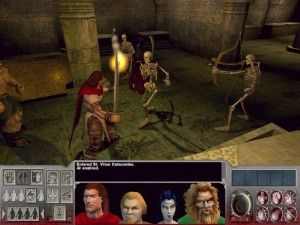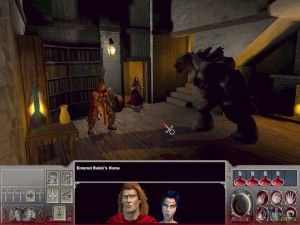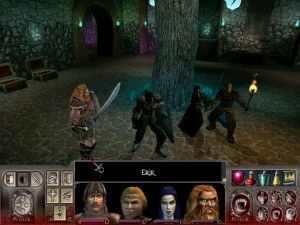Vampire The Masquerade Redemption Full PC Game


Game Information
| Official Name | Vampire: The Masquerade – Redemption |
| Version | Full Game |
| File Upload | Torrent |
| Developer (s) | Nihilistic Software |
| Publisher (s) | Activision |
| Director (s) | Ray Gresko |
| Programmer (s) | Rob Huebner |
| Artist (s) | Maarten Kraaijvanger |
| Platform (s) | PC, Windows |
| Release date (s) | June 7, 2000 |
| Genre (s) | Role-playing |
| Mode (s) | Single-player, multiplayer |
Screenshots
Overview
Vampire The Masquerade Redemption Full PC Game Overview
Vampire The Masquerade Redemption Download Free Full Game is a 2000 role-playing video game developed byNihilistic Software and released by Activision forMicrosoft Windows and Mac OS. Set in White Wolf Publishing's World of Darkness, the game is based on White Wolf's role-playing game Vampire: The Masquerade and follows the adventures of Christof Romuald, a 12th century French crusader who is killed and subsequently revived as a Vampire. The game depicts Christof's centuries-long journey from the Dark Ages of 12th century Prague and Vienna to modern-day London and New York City in search of his humanity and his kidnapped love, the nun Anezka. Vampire The Masquerade Redemption Free Download.
Redemption is presented in the first- and third-person perspectives. The player controls Christof and up to three allies through a linear structure, providing the player with missions to progress through a set narrative. Certain actions committed by Christof throughout the game can raise or lower his humanity, affecting which of the game's three endings the player receives. As a Vampire, Christof is imbued with a variety of abilities and powers that can be used to combat or avoid enemies and obstacles. Use of these abilities drains Christof's supply of blood which can be replenished by drinking from enemies or innocents. It includes multiplayer gameplay called «Storyteller», which allows one player to create a narrative for a group of players with the ability to modify the game dynamically in reaction to the players' actions.
Founded in March 1998, Nihilistic's twelve-man team began development of Redemption the following month as their first game. It took the team twenty-four months to complete on a budget of US$1.8 million. The team relied on eight outside contractors to provide elements that the team could not supply, such as music and artwork. The game's development was difficult: late changes to software forced the developers to abandon completed code and assets; a focus on high-quality graphics and sound meant that the game ran poorly on some computer systems; and the original scope of the game exceeded the game's schedule and budget, forcing the team to cancel planned features.
The game received a mixed critical response; reviewers praised its graphics and its multiplayer functionality, but were polarized by the quality of the story and combat. It received the 1999Game Critics Awards for Best Role-Playing game. Redemption was released for Microsoft Windows on June 7, 2000, with a Mac OS version following in November 2001. It was successful enough to merit the production of a sequel, Vampire: The Masquerade – Bloodlines, which was released in November 2004 as an indirect sequel set in the same fictional universe. Vampire The Masquerade Redemption Free Download PC Game.
Gameplay
Vampire: The Masquerade – Redemption—shortened toRedemption—is a role-playing game (RPG) presented primarily from the third-person perspective; the playable character is shown on the screen while an optional first-person mode used to view the character's immediate environment is available. The camera can be freely rotated around the character and positioned above it to give a greater overview of the immediate area. The game follows a linear, mission-based structure. Interaction is achieved by using a mouse to click on an enemy or environmental object to attack it or to activate it. Interaction is context based; clicking on an enemy initiates combat, while clicking on a door causes it to open or close.
The playable character can lead a group of three additional allies into battle, controlling their actions to attack a single enemy or to use specific powers. Characters can be set to one of three modes: defensive, neutral, or offensive. In defensive mode, the character remains distant from battles, while offensive mode sends the character directly into battle. The main character and active allies are represented by portraits on screen that reflect their current physical or emotional state, showing sadness, anger, feeding, or the presence of injuries or staking—having been stabbed through the heart and rendered immobile.
The player can access various long-range and melee weapons including swords, shields, bows, and guns, stakes, and holy water. Some weapons have a secondary, more powerful attack; for example a sword can be spun to decapitate a foe. Because they are vampires, allies and enemies are susceptible to damage from sunlight. Disciplines (vampiric powers) are used to supplement physical attacks. Each discipline can be upgraded, becoming a more powerful version of itself; alternatively, other in-game benefits can be gained. The game features disciplines that allow the player to enhance the character's physical abilities such as speed, strength, or durability. Disciplines can also allow the player to mesmerize an enemy or a potential feeding victim, render the character invisible to escape detection, turn the character into mist, summon serpents to attack enemies, heal, revive their allies, and teleport to a haven. Vampire The Masquerade Redemption for PC.
Each discipline can be upgraded up to five times, affecting the abilities' durations, the scale of the damage or their effect, and the cost of using it. The characters' health and disciplines are reliant on blood, which can only be replenished by feeding on the living—including other party members—or finding blood containers such as bottles and plasma bags. Drinking an innocent to death and other negative actions reduces the player's humanity, increasing the likelihood of entering a frenzy when injured or low on blood, during which they indiscriminately attack friend and foe.
Completing objectives and defeating enemies is rewarded with experience points, which are used to unlock or upgrade existing disciplines and improve each characters' statistics, such as strength or agility. Weapons, armor, and other accessories can be purchased or upgraded using money or valuable items, which are collected throughout the game. The character's inventory is grid-based; objects occupy an allotted amount of space, requiring the management of the storage space available. A belt allows some items to be selected for immediate use during gameplay, such as healing items, without the need to access them in the main inventory. The first version of the game allows progress to be saved only in the main character's haven or safehouse; it automatically saves other data at specific points. An update to the game enabled players to save their in-game data at any point in the in-game narrative.
Redemption features an online multiplayer component which allows players to engage in scenarios together. One player assumes the role of the Storyteller, guiding other players through a scenario using the Storyteller interface. The interface allows the Storyteller to create or modify scenarios by placing items, monsters, and characters across the map. Character statistics, such as experience points, abilities, and disciplines, can also be modified. Finally, the Storyteller can assume the role of any character at any given time. These functions allow the Storyteller to dynamically manipulate the play environment while the other players traverse it.
Development
The development of Vampire: The Masquerade – Redemptionbegan at Nihilistic Software in April 1998,[50] shortly after the developer's founding in March that year.[51] Its development was publicly announced in March 1999.[52] Intending to move away from the first-person games the team members had worked on with previous companies, Nihilistic prepared a design and story for a futuristic RPG with similar themes and gothicaesthetics to those of the Vampire: The Masqueradeseries.[50][51] After publisher Activision approached the team using the White Wolf license, they adapted parts of their original design to fit the Vampire series, which became the original design for Redemption.[50] Endorsement by Id Softwarefounder John Carmack helped Nihilistic decide to work with Activision.[51] The Nihilistic team developed Redemption over twenty-four months; the team expanded to twelve members by the end of development.[50] The development team included Nihilistic President and CEO Ray Gesko,[53] lead programmer Rob Huebner,[54] world designer Steve Tietze, level designer Steve Thoms, lead artist Maarten Kraaijvanger, artist Yujin Kiem, art technician Anthony Chiang, and programmers Yves Borckmans and Ingar Shu.[51]
Activision provided a budget of US$1.8 million; the amount was intentionally kept low to make the project manageable for Nihilistic and reduce the risk to Activision, which was relatively inexperienced with RPGs at the time.[50] Nihilistic's management was committed to the entire team working in a one-room environment with no walls, doors, or offices, believing this would force the individual groups to communicate and allow each department to respond to queries immediately, saving hours or days of development time.[54] Redemption 's story was developed with input from Wolf; it was co-written by Daniel Greenberg, a writer for the source pen-and-paper RPG.[55]
The small size of the team led to Nihilistic relying on eight external contractors to provide elements the team could not supply.[54][56] Nick Peck was chosen to provide sounds effects, ambient loops, and additional voice recordings based on his previous work on Grim Fandango (1998). Kevin Manthei provided the musical score for the game's 12th century sections, while a duo called Youth Engine provided the modern-day sections' score. Some artwork was outsourced; Peter Chan (Day of the Tentacle (1993) and Grim Fandango) developed concept art to establish the look of the game's environments, and Patrick Lambert developed character concepts and full-color drawings for the modelers and animators to use. Huebner considered the most important external relationship was with a small start-up company called Oholoko, which produced cinematic movies for the game's story elements and endings. Nihilistic met with various computer animation firms but their prices were too expensive for the project budget.[54]
Redemption was officially released to manufacturing on May 30, 2000.[57] The game features 300,000 lines of code, with a further 66,000 lines for JAVA scripts.[56] In January 2000, it was announced that Nihilistic was seeking a studio to port Redemption to the Sega Dreamcastvideo game console, however this version was never released.[58] In February 2001, after the release of the PC version, it was announced that MacSoft Games was developing a MacOS version of the game.[59]
Technology
Nihilistic initially looked at existing game engines such as the Quake engine and Unreal Engine,[50] but decided those engines, which were primarily designed for first-person shooters, would not be sufficient for its point-and-click driven RPG and decided to create its own engine for development of Redemption. This was the NOD engine, which the developers could customize for the game's 3D perspective and role-playing mechanics.[50][60][61] The team also considered that developing its own engine would allow it to freely reuse code for future projects or to license the engine for profit.[50] NOD was prototyped using the Glide application programming interface (API) because the team believed it would be more stable during the engine's development, intending that once the engine was more complete, it would be moved to a more general API designed to support a wide range of hardware such as Direct3D. However, once a basic engine was in place in Glide, the programmers turned their attention to gameplay and functionality. By June 1999, Redemption was still running in Glide, which at that point lacked some of the basic features the team needed to demonstrate at that year'sElectronic Entertainment Expo. When the team eventually switched to Direct3D, it was forced to abandon some custom code it had built to compensate for Glide's limitations such as texture and graphic management, which required the re-exporting of hundreds of levels and models for the new software. The late API switch also limited the time available to test the game's compatibility on a wide range of hardware.[56] The team focused on building the game forhardware accelerated systems to avoid the limitations of supporting a wider range of systems, which had restricted the development of the company founders' previous game, Star Wars Jedi Knight: Dark Forces II (1997).[61]
The programmers suggested using 3D Studio Max for art and level design, which would save money by allowing the company to license a single piece of software, but the lead artists successfully lobbied against this plan, believing that allowing the respective teams to choose the software would allow them to work most efficiently. Huebner said this saved the project more time than any other decision made during development. The level designers choseQERadiant to take advantage of their previous experience using the software while working on Id Software's Quake series. Id allowed Nihilistic to license QERadiant and modify it to create a customized tool for its 3D environments. Because QERadiant was a finished, functional tool, it allowed the level designers to begin developing levels from the project's start and then export them into the NOD engine, rather than waiting for up to six months for Nihilistic to develop a custom tool or learning a new 3D level editor. In twenty-four months, the three level designers built over 100 in-game environments for Redemption.[54] They obtained blueprints and sketches of buildings from medieval Prague and Vienna to better represent that period and locations.[55] The four-person art team led by Kraaijvanger used Alias Wavefront Maya to create 3D art. Nihilistic's management wanted Kraaijvanger to use a less expensive tool but relented when the cost was found to be lower than had been thought. Throughout the project, the art team built over 1,500 3D models.[54]
At the start of development, Nihilistic wanted to support editing of the game by the user-community, having seen the benefits to the community while working on other games. Staff who worked on Jedi Knight knew the experience of creating a new, customized programming language called COG that gave the programmers the results they wanted but cost time and significant project resources. With Redemption, they wanted to incorporate an existing scripting engine that would more easily enable users to further develop the game instead of developing their own code again, which would consume months of development time. The team tested various languages, but became aware of another studio, Rebel Boat Rocker, which was receiving attention for its use of the Java language. Speaking to that studio's lead programmer Billy Zelsnak, Nihilistic decided to experiment with Java, having little prior knowledge of it. The language successfully integrated into the NOD engine without problems, providing a standardized and freely distributable scripting engine. Several designers were trained to use Java to allow them to build the several hundred scripts required to drive the game's storyline. Vampire The Masquerade Redemption Download Torrent.
Vampire The Masquerade Redemption Free Download PC Game
Click on below button to start Vampire The Masquerade Redemption Download Free PC Game. It is a Full Version PC Game. Just download torrent and start playing it.







